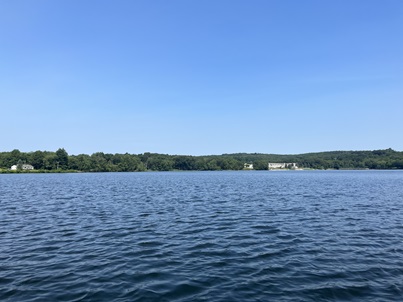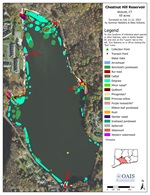Chestnut Hill Reservoir, Wolcott - 2023
2023 Aquatic Plant Survey Map of Chestnut Hill Reservoir
Chestnut Hill Reservoir, also known as Lyman Pond, is a 65-acre waterbody located in Wolcott, CT. It is carry-in only, with no motors allowed, accessible via Lyman Road. It is managed by the Town of Wolcott with some houses along the shoreline, but a large portion of the eastern shoreline is town-owned land.
CAES OAIS performed the first aquatic plant survey of the reservoir in July of 2023. A total of 17 plant species were mapped. Of these, three were invasive: minor naiad (Najas minor), phragmites (Phragmites australis), and purple loosestrife (Lythrum salicaria). Minor naiad is an annual, low-growing, invasive aquatic plant that is often found in the shallows. The largest populations of minor naiad were near transects 1, 3, and 5. Native slender naiad (Najas flexilis) can be commonly confused with minor naiad, and they were often found growing together in the reservoir. Minor naiad has highly curled, toothed, brittle leaves whereas slender naiad is often longer with smoother leaves that have no teeth. Phragmites and purple loosestrife are invasive wetland plants found on the shoreline. Phragmites was found frequently along the northern shoreline of the reservoir with one small patch on the southern shoreline. Purple loosestrife was found in one very small location on the southwestern shoreline along the road.
The center of Chestnut Hill Reservoir is too deep to support plants, but plants were present throughout the majority of areas shallow enough to support plants. Fourteen native species were found in the reservoir. Eelgrass (Vallisneria americana) and Berchtold’s pondweed (Potamogeton berchtoldii) were the most common plants and found throughout the shallow areas. Cattails (Typha species) and rush (Juncus species) are native wetland species. Arrowhead (Sagittaria species), bur-reed (Sparganium species), quillwort (Isoetes species), primrose-willow (Ludwigia species), spikerush (Eleocharis species), and waterwort (Elatine species) are low-growing native species found in very shallow waters near the shoreline. Ribbon-leaf pondweed (Potamogeton epihydrus), snailseed pondweed (Potamogeton bicupulatus), and western waterweed (Elodea nuttallii) were found near transects 1 and 5.
Overall, there are a diverse number of native species found at Chestnut Hill Reservoir with one invasive aquatic plant (minor naiad) and two invasive wetland plants (phragmites and purple loosestrife). During our survey, no plant species came to the surface or impeded access; however, later in the season it is possible that the abundant eelgrass and Berchtold’s pondweed could reach the surface in some areas.
| Species recorded in our 2023 survey of Chestnut Hill Reservoir Scientific Names *Invasive |
||
| Arrowhead | Quillwort | Slender naiad |
| Berchtold's pondweed | Phragmites* | Snailseed pondweed |
| Bur-reed | Primrose-willow | Spikerush |
| Cattail | Purple loosestrife* | Waterwort |
| Eelgrass | Ribbon-leaf pondweed | Western waterweed |
| Minor naiad* | Rush | |



